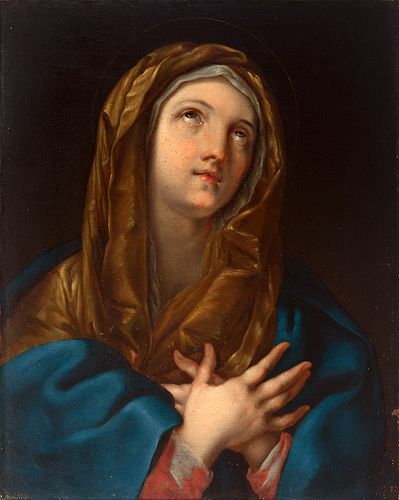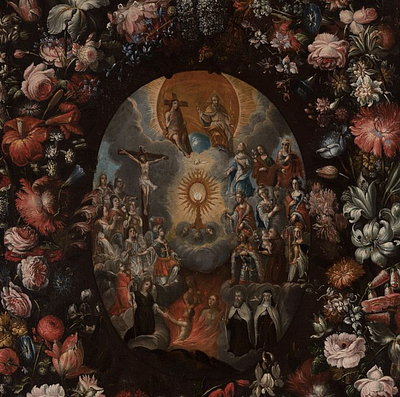Italian School of the late seventeenth century. Circle of GUIDO RENI (Calvenzano di Vergato, Bologna, 1575 - Bologna, 1642). "Dolorosa". Oil on canvas
Lot 110
About Seller
Setdart Auction House
Carrer Aragó 346
Barcelona
Spain
Setdart Subastas was born in 2004 and is currently the first online art auction in Spain with solidity, prestige and reliability guaranteed by our more than 60,000 users. Setdart has a young, dynamic and enterprising team ready to successfully manage the purchase and sale of art works through custom...Read more
Estimate:
EUR€4,000 - EUR€4,500
$4,301.08 - $4,838.71
Absentee vs Live bid
Two ways to bid:
- Leave a max absentee bid and the platform will bid on your behalf up to your maximum bid during the live auction.
- Bid live during the auction and your bids will be submitted real-time to the auctioneer.
Bid Increments
| Price | Bid Increment |
|---|---|
| EUR€0 | EUR€10 |
| EUR€200 | EUR€25 |
| EUR€500 | EUR€50 |
| EUR€1,000 | EUR€100 |
| EUR€3,000 | EUR€200 |
| EUR€5,000 | EUR€500 |
| EUR€10,000 | EUR€1,000 |
| EUR€20,000 | EUR€2,000 |
| EUR€50,000 | EUR€5,000 |
About Auction
By Setdart Auction House
Jul 14, 2021
Set Reminder
2021-07-14 06:30:00
2021-07-14 06:30:00
America/New_York
Bidsquare
Bidsquare : OLD MASTERS
https://www.bidsquare.com/auctions/setdart-auction-house/old-masters-7202
Setdart Auction House sofia@setdart.com
Setdart Auction House sofia@setdart.com
- Lot Description
Italian School of the late seventeenth century. Circle of GUIDO RENI (Calvenzano di Vergato, Bologna, 1575 - Bologna, 1642). "Dolorosa". Oil on canvas. Re-drawn. Size: 61 x 48 cm; 72 x 60 cm (frame). Judging by the formal and stylistic characteristics, the present work has been carried out by a painter of the Guido Reni circle, undisputed master of the Roman-Bolognese classicism together with Albani and Domenichino. Thus, we are faced with the representation of the Virgin Mary in her dedication as Dolorosa, portrayed on a neutral background, with a powerful diagonal spotlight illuminating the figure. Formally, Mary is presented bust-length, raising her gaze towards the source of the light, in ecstasy and with a subtle and elegant gesture. The undisputed master of Roman-Bolognese classicism along with Albani and Domenichino, Guido Reni was undoubtedly the best of the three. Closely linked to the Carracci family and to the city of Bologna, they all had a similar trajectory. They trained in Bologna with Denys Calvaert, and then moved on to the Accademia degli Incamminati, directed by Ludovico Carraci. In 1600 Reni arrived in Rome, where he worked with Annibale Carracci in the Farnese Gallery. His best period begins in these years; in 1609, at Annibale's death, Reni remains as the head of the classicist school. In the city he will be protected by Scipione Borghese, the future Pope Paul V, for whom the painter will realize one of his most important works, "La Aurora" (Palazzo Rospigliosi). It shows something that will always be characteristic of Reni's style, his admiration for ancient sculpture. Starting from the classical statues, he develops an ideal of beauty and perfection that will be much admired by the following painters. In 1614 he returned to Bologna for good. Reni's style evolves in a clear direction, more and more sculptural and cold, more and more fully classicist. His mature work will be characterized by a cold palette, with silvery reflections. Finally, from the 1930s onwards, his style became sketchy, with an unfinished appearance and a tendency towards monochrome, of great interest from a technical as well as a formal point of view.Guido Reni is currently represented in the most important art galleries around the world, including the Prado Museum, the Hermitage, the Louvre, the Metropolitan Museum in New York and the National Gallery in London, among many others.
- Shipping Info
-
In-house shipping available. Please inquire at admin@setdart.com.
-
- Buyer's Premium



 EUR
EUR CAD
CAD AUD
AUD GBP
GBP MXN
MXN HKD
HKD CNY
CNY MYR
MYR SEK
SEK SGD
SGD CHF
CHF THB
THB















